

Today’s political climate and the urgency of issues like climate change, a weak global economy and a deteriorating global security landscape have shortened the timeframe leaders have to deliver results.

By Mirek Dušek, et.al.
Managing Director
World Economic Forum
Introduction
Political shockwaves cut across many continents this past year – a “super year” of elections in which half the world’s population had the opportunity to go to the polls.1 For the first time, every governing party facing an election in a developed economy lost vote share.2 These expressions of electorate disapproval are due, in large measure, to forces that have been building for over a decade and were intensified by the COVID-19 pandemic. A sense of insecurity – financial or personal – has increased alongside feelings that the “system” has not been working. People around the world are looking for solutions while expressing a desire for change to the mechanisms meant to deliver results.
At the same time, the global order that held for the first 30 years after the end of the Cold War has passed. Today, competition and conflict are rising, and countries are re-examining their place in the world. Alongside geopolitical upheaval, technological change is also under way. The rapid development and uptake of frontier technologies such as generative artificial intelligence is poised to reshape economies and societies.
While the geopolitical dial won’t, and shouldn’t, turn back to the order of the past, it must turn more towards cooperation. Advancing global health, prosperity and resilience cannot be done by single nations alone. Resolving ongoing security challenges can only happen through multilateral and multistakeholder processes. Unlocking the benefits of technological innovations in an equitable way while ensuring necessary guardrails are in place to mitigate risks will require some form of coordination.
As a result, leaders will need new mechanisms for working together on key priorities, even as they disagree on others. The past several years have shown this balance is possible. Foreign investment announcements are increasing across the world and data and intellectual property (IP) are flowing between countries in ever greater quantities. Meanwhile, global commitments to climate- and resilience-linked finance continue to grow.
It is against this backdrop that the World Economic Forum and McKinsey & Company have released this second edition of the Global Cooperation Barometer with a focus on where cooperation stands today and what it can look like in the new technological age. The inaugural 2024 report stated its intentions: to serve as a tool for leaders to better understand the contours of cooperation broadly and along five pillars – trade and capital flows, innovation and technology, climate and natural capital, health and wellness, and peace and security. In its second year, the barometer draws on new data from the 41 indicators to offer an updated picture of the state of cooperation today: overall cooperation has been steady, with some significant drops that are offset by other gains.
The hope is that by measuring the state of cooperation, the barometer can track trends and identify the potential for new areas of cooperation and help plot a path forward.
About the Global Cooperation Barometer
Overview
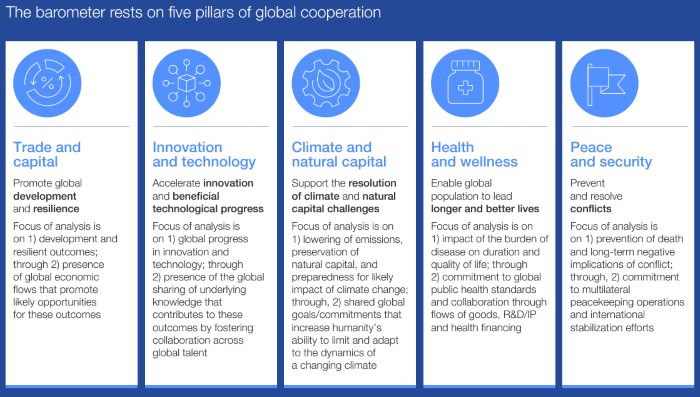
The Global Cooperation Barometer is structured along five dimensions of global connection: trade and capital, innovation and technology, climate and natural capital, health and wellness, and peace and security.
These five pillars were chosen because of their impact on global development and their explicit dependence on cooperative efforts among nations and economies. As a guiding element in the analysis, the barometer identified goals that actors are working towards in each of these themes. In doing so, the barometer draws inspiration from the United Nations Sustainable Development Goals (SDGs) and the efforts of other global institutions.
To quantify change in these pillars, 41 indicators were identified that research suggests are either cooperative actions that advance progress towards the goals of the pillars or demonstrate a broad outcome from those actions. Cooperative action metrics measure actions that provide evidence of cooperation; these indicators (such as flows of goods and exchange of intellectual property) are evidence of real, manifested cooperation and do not include “on paper” commitments.
Outcome metrics (such as life expectancy) measure the progress of cooperation but are typically influenced by additional factors beyond cooperation. The metrics span countries in all geographies and all levels of development.
The barometer examines the period from 2012 to 2023 to establish a trend line of cooperation. It indexes data to 2020 for the following reason: as the COVID-19 pandemic (hereafter referred to as “the pandemic”) took hold, it accelerated many existing trends in business and society and set many new ones in motion. Indexing the time series to 2020 highlights the trends in place before the pandemic and those that emerged from it. Note that some metrics have been inverted so that any increase represents a positive development.
Though this tool is imperfect and necessarily incomplete, it offers an overview of global cooperation that both captures broad trends and identifies important nuances.
The methodology used for the Global Cooperation Barometer is outlined on the following page. Details on sourcing of individual metrics are in the Appendix.
Data Coverage
- Geography – Across all metrics, the barometer aims to collect global data. In most cases, an aggregate global weighted average is available. When a global weighted average is not available, the most comprehensive data is used – such as Organisation for Economic Cooperation and Development (OECD) member countries, or a sample set of countries where data is available for all years.
- Years – While the barometer measures cooperation from 2012 through 2023, some metrics do not have data for all years. All metrics have 2020 data to ensure the indexed trendline can be calculated.
Index Calculation
- Indexed Trendlines – Data from 2020 serves as the base year to develop comparable trendlines, with all values in 2020 equal to one (2020 = 1). This baseyear standardization is the basis of the score calculation, enabling a uniform reference point for all metrics and comparability, despite different units and datasets.
- Data Normalization – Where possible, metrics are normalized to ensure that trendlines can be assessed independently of the effects of economic growth or population changes. For example, trade, capital and other financial flows are normalized to global GDP (gross domestic product) while migration metrics are normalized to global population levels.
- Weighting – Each pillar comprises two indices: an action index and an outcome index. To arrive at each, the metrics within are weighted equally (i.e. the action index is a simple average of metrics measuring cooperative actions). The overall index for a pillar is calculated as an average of the action and outcome metrics. Aggregate indices across pillars are also calculated as a simple average of pillar indices (i.e. equal weighting across pillars).
Executive Summary

As the world transitions from what had been a stable post-Cold War global order to a new, more unsettled and unpredictable period, political and geopolitical turbulence has the potential to degrade global cooperative efforts. But it does not need to. Amid mounting economic, environmental, technological and security challenges, constituencies may not be in favour of current methods but are looking for collaborative solutions to, rather than retreat from, these issues.
As a result, leaders will need to be adaptive and innovative within today’s more disordered context, identifying new ways to work with partners to deliver results. Progress will be especially important, not only because the patience of populations is wearing thin but because time is running out. As the world enters the latter half of the decade, there is limited time to meet the Sustainable Development Goals (SDGs), of which just 17% are currently on course.3
This lack of progress comes as the past year was the hottest on record, the global economy faces weak growth prospects and global security is at a crisis point. Many of these challenges caused voters around the world to express a desire for a change to the status quo. Yet, despite strong voter backlash last year against sitting governments, there are signals that constituencies are looking to accelerate rather than derail solutions. For instance, a large share of the global population wants their respective country to do more when it comes to addressing climate change.4
At the same time, advancements in frontier technologies are racing ahead faster than mechanisms can be developed to address their risks and share their benefits. Leaders – even those who may be market or geostrategic competitors – will need to work together to unlock the benefits of technology while placing appropriate safeguards around it.
The Global Cooperation Barometer 2025 uses 41 indicators to measure the current state of global cooperation. As with last year’s inaugural edition, the aim is to offer leaders a tool to better understand the contours of cooperation broadly and along five pillars: trade and capital flows, innovation and technology, climate and natural capital, health and wellness, and peace and security. In this way, leaders can identify what is working and what is not, and adjust course accordingly.
The barometer finds that after trending mostly positively for the better part of a decade, overall global cooperation is above pre-COVID-19 pandemic (hereafter referred to as “the pandemic”) levels but has flatlined over the past three years. A key reason for the stall has been the significant degradation in global peace and security, which has pulled the barometer’s overall measurement down. Still, the barometer shows that while cooperation may be slowing in some areas, there are also signs of growth.
- Trade and capital: cooperation dropped slightly, driven mostly by reductions in goods trade in China and developing economies. These declines were partially offset by growing f lows of capital, services and people.
- Innovation and technology: digitization of the global economy continues to drive increased cooperation, but global fragmentation of frontier technologies could slow global productivity growth.
- Climate and natural capital: cooperation continues to show strength, but it needs to improve much more and much faster if the world is to meet climate and natural capital goals.
- Health and wellness: health outcomes like life expectancy continue to improve postpandemic, but cross-border development assistance for health is falling.
- Peace and security: the world’s collective security system is under severe pressure from geopolitical tensions. Cooperation on this pillar deteriorated and pulled down the overall barometer. Increased conflicts and the high number of forcibly displaced people are prominent challenges.
Ultimately, as last year’s edition presented, the foundation of resilience, security and growth is cooperation. The question leaders must ask themselves, then, is not whether they should cooperate, but how.
The State of Global Cooperation
Overview
Global cooperation is above pre-COVID-19 pandemic levels, but only barely, and has stagnated since 2020. The flatlining of cooperation comes as the world is entering a state of greater instability caused by high levels of electoral discontent and geopolitical rivalry.
The last year saw elections in 72 countries, with many incumbent governments, both left and right facing strong voter backlash. The common message among electorates has been for change to the status quo. At the same time, global tensions have risen, threatening to undermine prior patterns of multilateral cooperation.
A “purgatory of polarity”, as the United Nations (UN) Secretary-General António Guterres termed it – in which global divisions widen and harden – is most stark when it comes to the degradation of security around the world.5 Russia’s invasion of Ukraine is approaching the three-year mark, ongoing conflicts in the Middle East have taken the lives of tens of thousands and the war in Sudan is creating a humanitarian crisis. All told, it is estimated that 122 million people worldwide are currently forcibly displaced, double the number from a decade ago.6 The inability of the international community to come together to prevent or stop this escalation of violence is the most serious concern about the state of the global cooperative muscle.
The concern with a stalled level of cooperation is that as the world enters the second half of the decade, with critical global deadlines ahead, progress is not where it needs to be. For instance, just 17% of the Sustainable Development Goals (SDGs) are on track to meet the 2030 deadline.7 Furthermore, as many communities have experienced, global temperatures have risen to record levels, with 2024 being the hottest year on record.8 Additionally, global economic growth is projected to be at historically weak levels (3.1% over the coming five years), according to the International Monetary Fund (IMF).9 This projection comes alongside a burgeoning debt crisis that has left over 3 billion people living in countries that spend more on debt interest than education or health.10
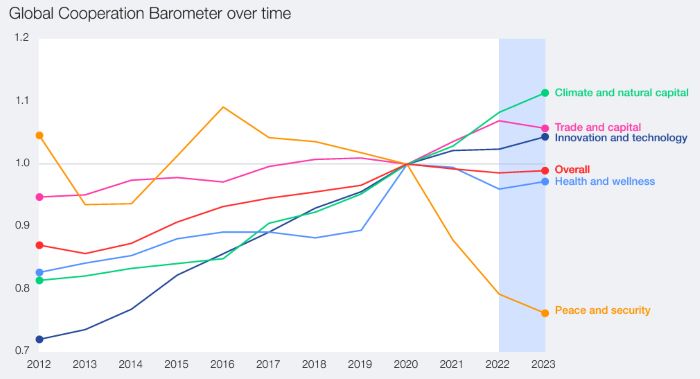
The sharp decline in global security has weighed heavily on the Global Cooperation Barometer’s calculation of global cooperation. It is a key reason the barometer shows that for the last three years, overall global cooperation has levelled off despite relatively stronger levels of cooperation in the areas of climate and nature, innovation and technology, and health and wellness (Figure 2).
However, the flatlining of cooperation does not mean that cooperation has completely receded. In September 2024, the UN General Assembly adopted the Pact for the Future – an ambitious agenda to strengthen international cooperation and revitalize multilateralism. In November, the world’s 20 largest economies agreed in Rio de Janeiro to a joint G20 Leader’s Declaration, a few days prior to a global agreement for a climate financing at the UN Climate Change Conference (COP29) in Baku. However, both did fall short of expectations, signalling that the global cooperative muscle, while working, is atrophying.
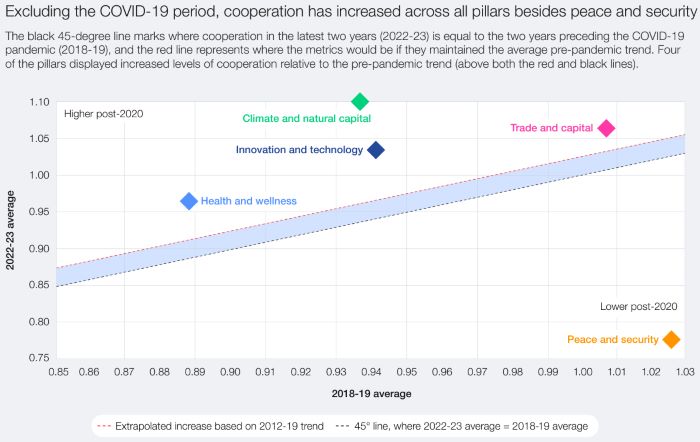
The mixed picture of cooperation is salient when comparing cooperation before and after the COVID-19 pandemic (Figure 3). Strengthened cooperation can be seen across four of the five pillars, notably when it comes to indicators that track the cross-border spread of knowledge, R&D, data flows and the increase of certain capital flows such as foreign investment and climate finance. However, these positive markers should be qualified in two ways; firstly, that rising flows were often concentrated in a few economies, potentially undermining the broad-based prosperity that is needed to sustain cooperative trends. Secondly, as noted, these flows remain well below levels required to reach collective goals (for example, reaching net-zero targets).
As the world moves further away from the postCold War era of cooperation and finds itself in a period of greater disorder, it is at risk of maintaining a new, structurally muted cooperative normal that offers fewer opportunities for actors to pursue solutions to known and emerging global issues together. To avoid this outcome, leaders will need to take steps that deliver immediate results to populations who are waiting for answers while putting the world on course towards achieving collective goals.
Innovation: A Frontline of Cooperation … and Competition
Frontier technologies are reshaping the global landscape. As the world enters a new period in which machine learning applications will scale across economies and societies, mastering artificial intelligence (AI) will be crucial for countries and companies to deliver growth.11 Generative AI alone could generate $2.6 trillion to $4.4 trillion in value across industries.12 Yet, while AI is projected to affect almost 40% of jobs around the world, according to the IMF, approximately half of these are at risk of redundancy.13
Both companies and countries are racing to position themselves competitively within this new reality. In just over a year since it was introduced, generative AI is being used by the organizations of 65% of respondents to a McKinsey & Company survey of global executives.14 At the country level, US federal investment in AI has accelerated significantly15 in recent years and China is expected to invest $1.4 trillion in its AI industry over the coming years.16 Saudi Arabia has committed17 to invest $100 billion in AI projects and India announced plans to develop a “national AI innovation ecosystem”.18
The rapid increase in national funding of AI, alongside restrictions in some countries over the ability to invest in foreign markets, raises the possibility of a new frontline of geostrategic competition, with the potential for an “AI arms race” in which countries compete in zero-sum rivalry for geostrategic advantage.19 This landscape of competition would complicate the ability to develop safeguards to mitigate the risks of new technology. Left ungoverned, AI could accelerate the dissemination of disinformation and bring new risks to peace and security. Yet, signs of cooperation have emerged. For instance, in November 2024 at a meeting in Peru on the sidelines of the APEC Summit, Chinese President Xi and US President Biden agreed to prevent AI from having control over nuclear weapons systems. In September, the UN Secretary-General’s High-level Advisory Body on AI issued its final report, Governing AI for Humanity, which presents the first global plan for addressing AI-related risks and ensuring the benefits of the technology are shared equitably.
In today’s challenging context, leaders will both need to find ways to work together to prevent new advancements in AI from being used for harmful purposes (either on its own or by malicious actors), and unlock benefits in the areas the Global Cooperation Barometer measures.
Trade and Capital: Crucial to and a Beneficiary of New Technologies

Well-functioning global cooperation in the form of trade and capital flow is a crucial requirement for the invention and deployment of new technologies. This type of cooperation includes the flow of financing for innovation, the flow of cross-border services to develop innovation, and the flow of materials and goods to manufacture and distribute innovation. Once technologies are developed, cooperation is needed to ensure that these technologies are shared equitably. Rising trade restrictions, especially in important innovation sectors such as low-carbon technologies, present significant risks to global cooperation and progress on sustainability goals and the global accessibility of these innovations.20
While trade is crucial for facilitating the development of new technologies, new technologies can offer immense efficiency gains and increased opportunities for trade. By some estimates, digitizing the trade ecosystem could increase trade across the G7 by nearly $9 trillion or nearly 43%.21
Climate and Natural Capital: Innovation as a Lynchpin of Meeting Green Goals
As much as 90% of 2050 baseline man-made emissions could potentially be abated using current technologies.22 However, less than 10% of the required deployment has occurred to date.23 Cooperation is needed to realize the potential of technologies and ensure they are deployed and equitably distributed. Indeed, the Paris Agreement notes “the importance of technology for the implementation of mitigation and adaptation actions” when it comes to climate action.24
Nascent innovations that are early in their development curve but could be crucial for the energy transition could also open (and rely on) new avenues of cooperation. For example, decarbonizing steel and ammonia could motivate new flows of hydrogen derivatives and “green iron” between economies in Africa and Europe.
Health and Wellness: Advancing Global Health Requires Shared Innovation
Frontier technologies are showing immense promise regarding the detection, diagnosis and treatment of diseases. Yet, these developments, as well as longstanding technologies such as imaging devices, are often limited in low- and middle-income countries.25 Cooperative approaches to bringing medical technology to underserved areas or developing innovation or production pipelines will be key to advancing global health priorities.
The many biomedical innovations born of cooperation that are now gaining momentum will continue to provide a tailwind for health outcomes around the world. The BioNTech/Pfizer COVID-19 vaccine – comprised of 280 components from 19 different countries26 – pioneered the use of mRNA (messenger ribonucleic acid) vaccines, which are now being studied for their potential to treat a range of diseases, from influenza to cancer.
At the same time, global collaboration is crucial to strengthening risk detection and protocols for pandemics. The World Health Organization’s (WHO) Hub for Pandemic and Epidemic Intelligence is working towards a world where collaborative surveillance empowers countries and communities to minimize the impact of pandemic and epidemic threats. Collaborative surveillance, preparedness, response and resilience facilitate the systematic strengthening of capacity among diverse stakeholders globally (both within and beyond the health sector) to enhance public health intelligence and improve evidence for decision-making.
Peace and Security: Innovation as a Tool for Accord
Technology has been a long-standing factor in shaping developments on the battlefield, but in recent years, new technologies have also helped with conflict response and even mitigation.
High-resolution satellite imagery has been indispensable in assessing infrastructure damage in Ukraine. Organizations such as the UN Institute for Training and Research (UNITAR) and private companies such as Maxar Technologies have provided up-to-date images of conflict zones. These images help map destroyed buildings, roads, bridges and utilities. The data supports humanitarian aid planning and lays the groundwork for future reconstruction efforts by identifying priority areas for rebuilding.
Organizations are using AI and technologies like secure content verification tools on the frontline of conflict to identify patterns of violence, monitor ceasefire agreements and help strengthen peacekeeping efforts.27 Improved cooperation could help prevent conflicts from spreading by identifying and countering misinformation online, defending computer systems against cyberattacks, and developing technology to help mitigate damage, such as early-warning systems, emergency services, and search and rescue.
Five Pillars of Global Cooperation
Overview
The Global Cooperation Barometer measures global cooperation across five areas, or pillars: trade and capital flows, innovation and technology, climate and natural capital, health and wellness, and peace and security.
Each pillar examines evidence of cooperative actions and outcomes of these actions to determine an overall level of global cooperation in that area.
Pillar 1: Trade and Capital

Cooperation dropped slightly, driven mostly by reductions in goods trade from China and developing economies. These declines were partially offset by growing flows of capital, services and people.

The trade and capital pillar looks at cooperation through flows of goods and services, trade, capital and people. It includes metrics about the magnitude of flows – such as foreign direct investment or labour migration – and the distribution of flows (including trade concentration and developing country share of manufactured goods). The global trade and capital flows pillar was on an upward trajectory from 2012 to 2022, overcoming even the volatility during the pandemic (see Figure 4).

In 2023, this pillar experienced a small decline, though almost all indicators remain above their pre-pandemic averages (above the black line in Figure 5). The exceptions are foreign portfolio investment (FPI) and trade concentration, which sit below their pre-pandemic averages.
Trade of goods dropped by 5% in 2023, partially reversing some of the large growth experienced in the prior two years.28 China accounted for nearly 15% of the reduction in global exports in 2023, and other emerging economies accounted for another 45% – both as a result of increased conflicts29 and slower economic growth. Trade between Western and Easternaligned economies declined, while trade between partners who are geopolitically aligned increased, indicating an apparent intensification of geopolitical fragmentation.30
The World Trade Organization (WTO) projects the goods trade will increase by 2.7% in 2024,31 but warns that “geopolitical tensions and increased economic policy uncertainty” are putting the near-term and medium-term growth forecasts into question. There are strong headwinds ahead – interventions such as tariffs have increased three- to six-fold on trade between the US and China, the world’s two largest economies, since 2017.32
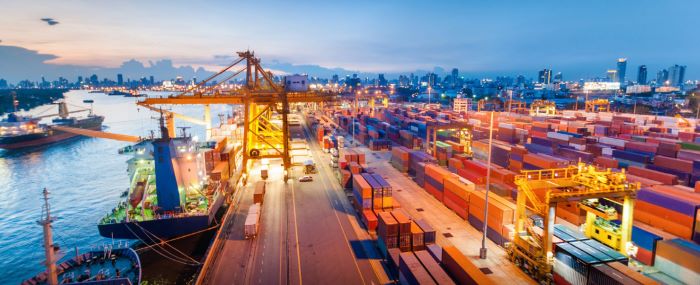
While goods trade has retreated, capital flows grew in 2023. Foreign direct investment (FDI) and FPI stocks outgrew GDP (gross domestic product) in 2023, a positive sign for cooperation, though the main beneficiaries were a small set of developed countries. Some of the largest FDI projects announced in 2023 were investments in strategic sectors, such as semiconductors, batteries and renewable energy, that were the focus of industrial policy, mostly in the US and Europe.
In fact, as the world fragmented further in 2023, developing economies saw a decline in their share of trade and capital flows. Their share of global manufacturing exports dropped by two percentage points (mostly due to a decrease from China), and their share of FDI inflows dropped by one percentage point. Developing economies also saw a flatlining of development assistance they received as a proportion of their gross national income (GNI).
Nonetheless, there were bright spots of increased interconnectedness. In 2023, labour migration increased by 4.1%, and remittances (the money foreign workers send to their home country) increased by 2.5%. Both have now surpassed their pre-2020 levels, indicating that flows of labour and immigration seem to have recovered from the COVID-19 period (in 2020, migration flows fell by 2.5% and remittances dropped by almost 5%).
Looking ahead, substantial uncertainty remains about the evolution of trade and capital flows, as economies continue to reconfigure their economic ties. A fragmented global economy risks setting back progress on global priorities such as reducing poverty and inequality and can dampen growth while fuelling inflationary pressures.33 Leaders will need to pursue policies that strengthen trade while also investing in domestic programmes such as training and education to help make trade more inclusive.34
Pillar 2: Innovation and Technology
Digitization of the global economy continues to drive increased cooperation, but global fragmentation of frontier technologies could slow global productivity growth.
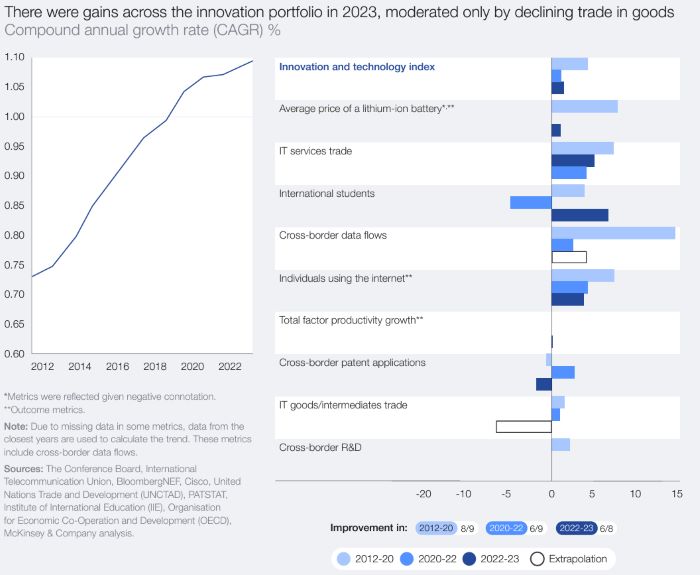
The innovation and technology pillar examines elements of global cooperation that can accelerate innovation and create beneficial technological progress. In 2023, growth in this pillar continued the positive trajectory it has seen since 2012 (see Figure 6).
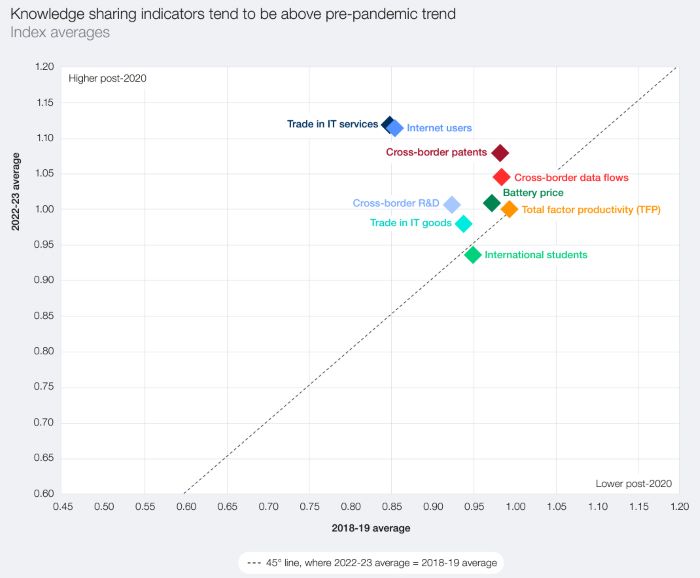
Almost all metrics remain above their pre-pandemic averages (above the black line in Figure 7). International students are the exception, which remain below their pre-pandemic average.
The digitization of the global economy continued to propel the growth of this pillar. In particular, IT services trade, cross-border data flows and the number of individuals using the internet continued to increase in 2023.
Global cooperation in technology and innovation also continued to drive global adoption of new technologies. Lithium-ion batteries, which rely on highly global value chains, saw their prices fall in 2023.35 This was partly driven by continued innovation and a strong ramp-up in the supply of intensely traded critical minerals inputs, often enabled by advances in prospecting and extraction technologies.
This drop in price supported a growth of 30% in the deployment of this technology.
Finally, in 2023, student flows started to rebound after their pandemic decline, although they remain below their pre-pandemic average.
Despite these positive signs, there are major questions about the global fragmentation of frontier technologies as different economies strive to maintain their advantages. Important supply chains, such as semiconductors, have been impacted by increased measures to control flows of raw materials and advanced technologies.36 The transfer of some intangibles around the globe has also slowed. Cross-border patent applications fell in 2023, and cross-border R&D fell in 2022 (the latest year for which this data is available).
All of these trends may be contributing to the worryingly stagnant trajectory of total factor productivity (TFP).37 While not the only indicator, TFP is a useful measurement of overall innovation. It measures the ratio of overall output (GDP) to overall inputs, with innovation being a key factor in increasing the productivity level.
Looking ahead, as innovation becomes a frontline of geostrategic considerations, leaders will need to identify pathways for implementing commonsense security measures while not cutting off cooperation. For instance, sovereign AI – developing AI systems and attendant capabilities within national borders – can be pursued alongside the advancement of multilateral partnerships that set standards, establish guardrails and facilitate cross-border data flows.38
Pillar 3: Climate and Natural Capital
Cooperation improved in 2023 but would need to improve much more and much faster if the world is to meet global climate and natural capital goals.
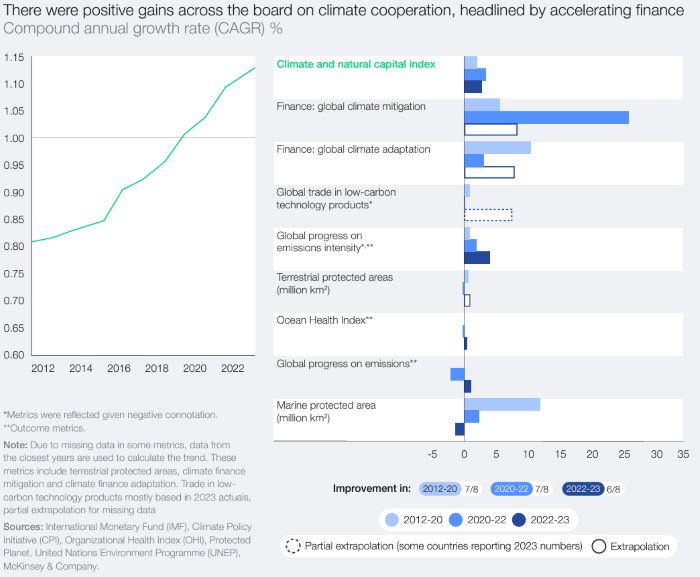
This pillar looks at the global cooperation on lowering emissions, preserving natural capital and preparing for the likely effects of climate change. Our measure shows modest improvement in 2023 (see Figure 8).
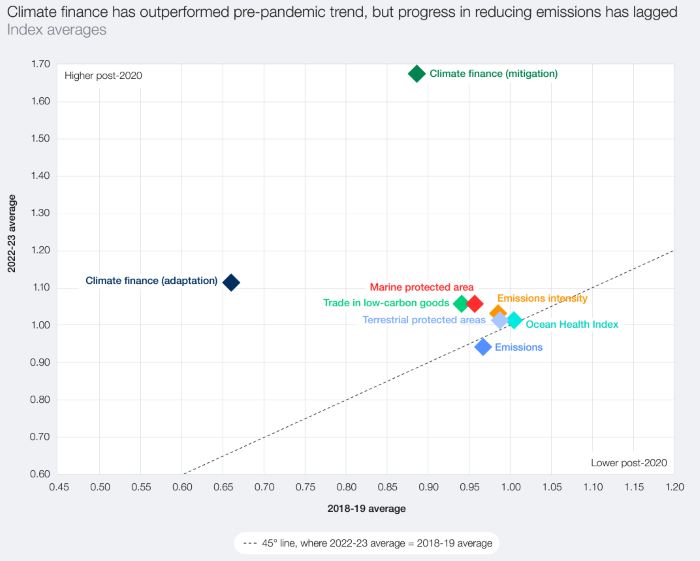
Nearly all metrics are above their pre-pandemic averages (black line in Figure 9). Nonetheless, because global emissions continue to rise, this pillar would need increased and accelerated cooperation if the world is to reach stated climate and natural capital goals.
In 2023, cooperation in this pillar grew as f inance and trade flows enabled improvements in deployment and emissions intensity. Climate f inance flows from both the public and private sectors reached new heights. Despite this growth, finance flows remain below the level required to make a meaningful impact. The capital committed to climate finance as of 2023 was between a tenth and a fifth of the projected annual needs for the world to reach net zero by 2030.39
The growth of finance flows also enabled expanded technology deployment and associated growth in trade. Trading in low-carbon technology products was 12% higher in 2023, one of the only categories of goods trade that saw growth. The acceleration of growth in the rollout of low-emissions technologies contributed to a decline in the emissions intensity of GDP (i.e. a reduction in emissions generated by unit of economic output). For example, solar and wind deployment moderated coal and gas demand for power generation, while the deployment of electric vehicles (EVs) led to less oil demand than would have otherwise been observed.40 These trends continued in 2024, with continued growth in the deployment of EVs (including a 25% year-on-year increase in the f irst half of 2024) and renewable energy (including a 36% year-on-year increase in the first half of 2024).41
Importantly, despite this progress, the world continues to be far from what would be required for a net-zero scenario. Absolute greenhouse gas (GHG) emissions grew in 2023 and are on track to set yet another record high in 2024.42
By some estimates, only around 10% of the required deployment of low-emissions technologies to meet climate goals has been achieved – and further progress would require more global cooperation, including more flows of trade and capital.43 For example, clean technologies, such as solar, wind and EVs, rely on well-functioning flows of critical minerals.44
Measures of cooperation relating to natural capital were mostly flat – including terrestrial protected areas and the ocean health index – or even declined last year, including marine protected areas (down by 1.3%).
Looking ahead, though elements of climate and nature cooperation may continue on a positive trajectory, protectionist policies in key economies may set back efforts to reach net zero by 2050. These challenges to advancing a global climate agenda should not be used as an excuse to delay other efforts in the near term, particularly scaling up carbon trading mechanisms, investing in green technologies and securing the additional financing needed to meet climate targets.45
Pillar 4: Health and Wellness
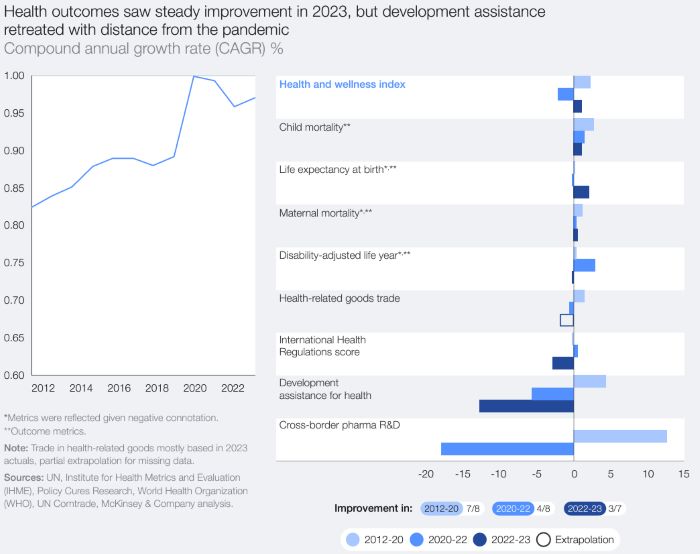
Health outcomes like life expectancy continue to improve post-pandemic – but cross-border assistance is falling.
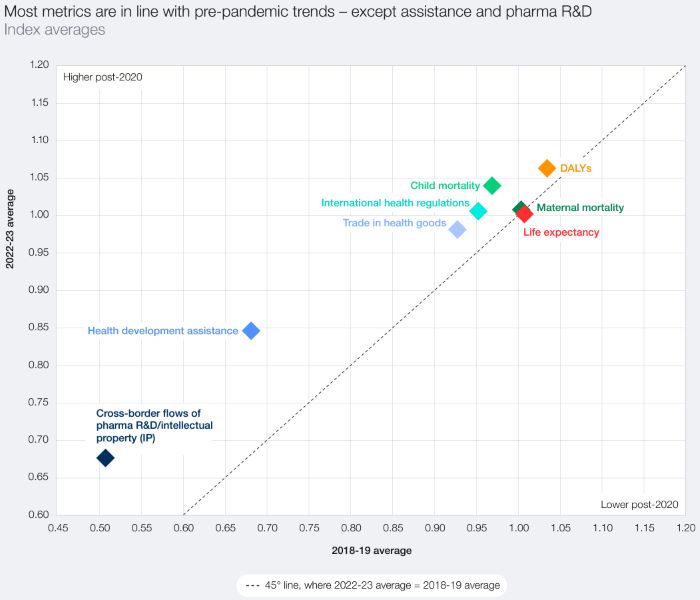
The health and wellness pillar looks at the impact of global cooperation on enabling people worldwide to live longer and better lives. Cooperation increased from 2012 to 2019 and spiked in 2020 as the world navigated the pandemic. There was a decline in 2021 and 2022, which was partially reversed in 2023. Almost all of the metrics in this pillar therefore remain above their pre-pandemic averages (represented by the black line in Figure 11).
In 2023, metrics related to health outcomes (child mortality, maternal mortality and life expectancy) improved, but at a slower rate than before the pandemic. Disability-adjusted life years (DALYs), one of the key measures of health, stagnated after significant improvement in 2022.
There is a risk that decreased cooperative actions now will eventually drag down health outcomes, as the former lags the latter. In fact, metrics related to cooperative actions, including cross-border assistance and pharmaceutical R&D, have continued to fall since 2020, although they remain above pre-pandemic levels.
There were other indications of flagging advancement in cooperation actions. For instance, trade in health-related goods, like most goods trade, fell this past year. International Health Regulations scores also declined, a sign that public health capacity was stagnating or falling around the world. Furthermore, the World Health Assembly (WHA) failed to align on a Pandemic Agreement (a comprehensive, binding framework under the WHO constitution to better prevent, prepare for and respond to future pandemics). The latter is a stark example of challenges in post-pandemic global cooperation on health and particularly concerning given the recent re-emergence of Mpox.
Additionally, the growing number and protracted nature of conflicts around the world could have a major negative effect on global health outcomes, both from the physical impacts of conflict and the cascading disruptions to health systems.46
Looking ahead, actors will need to build cooperative mechanisms to protect against global health threats so that they bolster their own health systems. Over the next 25 years, the global population aged 60 and over is projected to double. This means that many economies will need to share best practices for developing health systems that are sustainable and can support this burgeoning ageing population while they collaborate on addressing near-term global health risks.47
Pillar 5: Peace and Security
The world’s collective security system is under severe pressure from geopolitical divides, with actors unable to prevent or end conflict. Levels of conflict and attendant humanitarian crises have increased to record levels in the past year.

The peace and security pillar examines the impact of global cooperation in preventing and resolving conflicts. The focus is on the prevention of death and ameliorating the long-term negative implications of conflict through commitment to multilateral peacekeeping operations and international stabilization efforts.
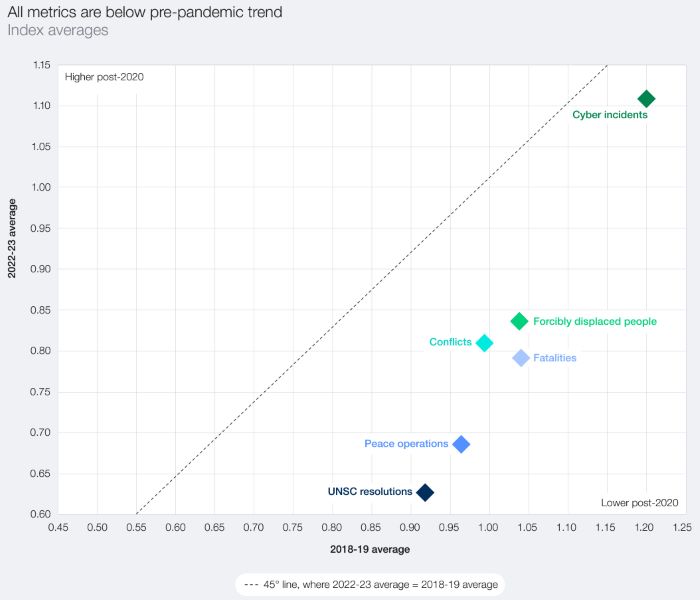
This pillar has deteriorated for the past seven years and continued its trajectory in 2023. All metrics in this pillar remain below their pre-pandemic averages (below the black line in Figure 13). The decline in this pillar had the largest impact on the overall barometer results.
Multilateral institutions that were created to prevent and resolve conflicts have largely been unable to do so in recent years. The result has been a continued increase in conflicts in 2023, with the continued deterioration of security, including but not limited to the Middle East, Russia-Ukraine and Sudan, and a significant increase in the number of forcibly displaced people, estimated at more than 118 million in 2023 and over 122 million as of 2024.48
Actions by the UN, such as new or augmented peacekeeping missions or resolutions from the UN Security Council, have been largely confined to humanitarian assistance rather than peace-making.49 Notably, the Security Council has not mandated a new peacekeeping operation since 2014. Instead, there has been a shift towards regionally led peace operations. Recent analysis by the International Peace Institute found that cooperative actions in peace and security decreased the most among several domains of the multilateral system,50 with the Security Council passing fewer resolutions in 2023 than in any year since 2013.
Although preliminary figures suggest fatalities declined in 2023, following a ceasefire in Ethiopia (one of the largest sources of casualties in 2022), final figures may be revised upward due to increased fatalities in Sudan, Ukraine, Gaza and other frontlines of war.51
Conflicts have also continued to figure extensively in the digital domain. Some measure of optimism can be seen in the fact that the number of significant cyber incidents was below the 2020 peak for the third consecutive year. That said, additional cooperation between governments and companies will be needed to improve cybersecurity standards and protect personal data and critical infrastructure. In September 2024, the UN General Assembly adopted the Pact for the Future, which includes commitments to “redouble” efforts to build and sustain peace, but thus far, progress on this agenda has remained elusive.52
Recommendations: The Need for Disordered Cooperation
Overview
Leaders across public and private sectors face new urgency in deepening cooperation on critical global objectives that they cannot advance alone. Yet, such cooperation is at risk of becoming elusive as the world seems poised to enter a period of instability and volatility – an era of greater geopolitical (and, in some cases, political) disorder.
Because the landscape is fast-changing, historical strategies for cooperation will likely be less effective than they once were. The following, therefore, are steps that leaders can take to build cooperation in today’s context:
Find Flexible Ways to Cooperate
Leaders should be open to new approaches to cooperation that may depart from the more orderly approach that was fit for a more stable global context. While existing partnership models and multilateral mechanisms may still offer the possibility of broad global agreements, leaders cannot rely solely on approaches that were designed for more collaborative climates. Instead, within today’s unsettled political and geopolitical periods, leaders must be opportunistic and open to dynamic partnerships that may differ from issue to issue. Though this approach may feel disordered, ultimately, it will likely have the greatest chance of delivering effective solutions.
Practice “Planned Opportunism”
Leaders must be ready to pivot quickly towards opportunities as soon as they emerge. “Planned opportunism” requires the ability to read weak geopolitical or market signals that offer early indications of emerging cooperative trends; it also requires the agility to rapidly reallocate resources to capture these nascent opportunities.53 To have this capacity, governments will need to be open to signals that may run counter to their assumptions or conventional thinking and build more nimble, responsive teams. Businesses will need to strengthen in-house geopolitical expertise and put in place mechanisms for reading these signals as well as empower teams to make decisions accordingly.
Redefine Proximity
To identify novel cooperative solutions, leaders will need to reevaluate what “proximity” means. While stakeholders who are geographically nearby, ideologically aligned or operate in the same sectors often make for natural partners, leaders will likely need to look further afield when it comes to forging solutions. This means potential partners should be seen as those who are not necessarily physically or ideologically nearby, but who are proximate to workable solutions and desirable outcomes.
Think Big by Starting Small
Leaders should not overlook what may appear to be small opportunities for cooperation. Starting with these small cooperative approaches can yield large long-term results, as the 2024 edition of the Global Cooperation Barometer advised, because, over time, cooperation can beget cooperation as trust among parties grows.
Consider “Structural Segmentation
In the private sector, firms are facing an existential question of whether they should remain global in a risk-filled landscape. One potential response is to pursue “structural segmentation”, which entails a series of moves to manage geopolitical exposure, to enable locally informed decisionmaking, and to clear a pathway to safe, stable growth. Structural segmentation can take several forms, from localizing parallel activities in multiple locations across the world to relocating towards home or geopolitically aligned countries, at least in select domains. This allows companies to retain a global footprint and its advantages while at the same time increasing resilience by reducing exposure to risks.
Conclusion
Importantly, today’s political climate and the urgency of issues like climate change, a weak global economy and a deteriorating global security landscape have shortened the timeframe leaders have to deliver results. Leaders will need to implement tools that are brutally honest in measuring progress and in keeping companies and countries only on pathways that are moving towards solutions. Staying the course on ineffective pathways will only build greater distrust among partners, leaders and between leaders and their constituents. However, being agile and pivoting to cooperative solutions will both deliver results and build trust among constituencies, creating a virtuous cycle in which trust in cooperation deepens and new opportunities for shared solutions emerge.
Endnotes
- United Nations Development Programme (UNDP). (n.d.). A ‘Super Year’ for Elections. https://www.undp.org/super-yearelections.
- Burn-Murdoch, J. (2024). Democrats join 2024’s graveyard of incumbents. Financial Times. https://www.ft.com/content/ e8ac09ea-c300-4249-af7d-109003afb893.
- United Nations Department of Economic and Social Affairs. (2024). With less than one fifth of targets on track, world is failing to deliver on promise of the Sustainable Development Goals, warns new UN report. https://www.un.org/en/withless-than-one-fifth-of-targets-on-track#:~:text=The%20report%20reveals%20that%20only,one%2Dthird%20stalled%20 or%20regressing.
- United Nations Development Programme (UNDP). (n.d.). Peoples’ Climate Vote 2024. https://peoplesclimate.vote/.
- United Nations. (2024). UN’s Guterres urges global solutions as uncertain world edges toward a ‘powder keg’. https://news.un.org/en/story/2024/09/1154771.
- United Nations High Commission on Refugees (UNHCR). (n.d.). Data and Statistics: Global Trends. https://www.unhcr.org/global-trends#:~:text=Over%20117.3%20million%20people%20were%20forcibly%20 displaced%20at%20the%20end%20of%202023.&text=This%20equates%20to%20more%20than%201%20in%20 every%2069%20people%20on%20Earth.&text=The%20number%20of%20displaced%20people%20has%20 increased%20every%20year%20for%2012%20years.
- United Nations. (2024). World on Track to Achieve Only 17 Per Cent of 2030 Agenda Targets, Speakers Warn, as Second Committee Takes Up Sustainable Development Reports. https://press.un.org/en/2024/gaef3604.doc. htm#:~:text=With%20only%20six%20years%20remaining,as%20it%20took%20up%20that.
- Abnett, K. & A. Withers. (2025). 2024 is the hottest year on record, EU scientists say. Reuters. https://www.reuters.com/ business/environment/2024-will-be-hottest-year-record-eu-scientists-say-2024-12-09/.
- International Monetary Fund (IMF). (2024). Steady but Slow: Resilience Amid Divergence. https://www.imf.org/en/Publications/WEO/Issues/2024/04/16/world-economic-outlook-april-2024.
- United Nations Trade and Development (UNCTAD). (2024). A world of debt Report 2024. https://unctad.org/publication/world-of-debt.
- Letzing, J. (2024). What’s an ‘intelligent economy’ and why are some economies more intelligent than others? World Economic Forum. https://www.weforum.org/stories/2024/04/how-some-economies-get-intelligent-while-others-don-t/.
- McKinsey & Company. (2023). The economic potential of generative AI: The next productivity frontier. https://www.mckinsey.com/capabilities/mckinsey-digital/our-insights/the-economic-potential-of-generative-ai-the-nextproductivity-frontier#introduction.
- Georgieva, K. (2024). AI Will Transform the Global Economy. Let’s Make Sure It Benefits Humanity. IMF Blog. https://www.imf.org/en/Blogs/Articles/2024/01/14/ai-will-transform-the-global-economy-lets-make-sure-it-benefitshumanity.
- Singla, A., A. Sukharevsky, L. Yee, M. Chui, et al. (2024). The state of AI in early 2024: Gen AI adoption spikes and starts to generate value. McKinsey & Company. https://www.mckinsey.com/capabilities/quantumblack/our-insights/the-state-of-ai.
- Larson, J., J. S. Denford, G. S. Dawson and K. C. Desouza. (2024). The evolution of artificial intelligence (AI) spending by the U.S. government. Brookings. https://www.brookings.edu/articles/the-evolution-of-artificial-intelligence-ai-spending-bythe-u-s-government/.
- Jiang, B. (2024). China’s AI industry could see US$1.4 trillion in investment in 6 years, executive says. myNEWS. https://www.scmp.com/tech/big-tech/article/3277743/chinas-ai-industry-could-see-us14-trillion-investment-6-yearsexecutive-says.
- Newman, M. and J. Love. (2024). Saudis Plan $100 Billion AI Powerhouse to Rival UAE Tech Hub. Bloomberg. https://www.bloomberg.com/news/articles/2024-11-06/saudis-plan-100-billion-ai-powerhouse-to-rival-uae-s-tech-hub.
- Reuters. (2024) India announces $1.2 bln investment in AI projects. https://www.reuters.com/technology/india-announces12-bln-investment-ai-projects-2024-03-07/.
- Shepardson, D., M. Martina and T. Hunnicutt. (2024). US finalizes rules to curb AI investments in China, impose other restrictions. Reuters. https://www.reuters.com/technology/artificial-intelligence/us-finalizes-rules-curb-ai-investmentschina-impose-other-restrictions-2024-10-28/.
- Evenett, S., A. Jakubik, F. Martín and M. Ruta. (2024). The Return of Industrial Policy in Data. https://www.imf.org/en/Publications/WP/Issues/2023/12/23/The-Return-of-Industrial-Policy-in-Data-542828.
- International Chamber of Commerce (ICC). (n.d.). G7 Creating a Modern Digital Trade Ecosystem. https://www.iccgermany.de/wp-content/uploads/2021/10/Creating-a-Modern-Digital-Trade-Ecosystem-G7.pdf.
- Heid, B., M. Linder, S. Mayer, A. Orthofer, et al. (2023). What would it take to scale critical climate technologies? https://www.mckinsey.com/capabilities/sustainability/our-insights/what-would-it-take-to-scale-critical-climatetechnologies.
- Krishnan, M., C. Bradley, H. Tai, T. Devesa, S. Smit and D. Pacthod. (2024). The hard stuff: Navigating the physical realities of the energy transition. McKinsey Global Institute. https://www.mckinsey.com/mgi/our-research/the-hard-stuff-navigatingthe-physical-realities-of-the-energy-transition.
- United Nations. (2015). Paris Agreement. https://unfccc.int/sites/default/files/english_paris_agreement.pdf.
- Song, Z. (2024). Access to medical technology saves lives. How can we make it more accessible in low- and middle-income countries? World Bank Blogs. https://blogs.worldbank.org/en/health/Access-to-medical-technology-saves-lives.
- Cueni, T. (2021). Challenges and solutions to scaling-up COVID-19 vaccine manufacturing capacity. The International Federation of Pharmaceutical Manufacturers and Associations (IFPMA). https://www.ifpma.org/insights/challenges-andsolutions-to-scaling-up-covid-19-vaccine-manufacturing-capacity/.
- United Nations Security Council. (2023). International Community Must Urgently Confront New Reality of Generative, Artificial Intelligence, Speakers Stress as Security Council Debates Risks, Rewards. https://press.un.org/en/2023/sc15359.doc.htm.
- World Trade Organization (WTO). (n.d.). World Trade Statistics 2023: Key insights and trends. https://www.wto.org/english/res_e/statis_e/statistics2023_e.htm.
- International Monetary Fund. (2024). World Economic Outlook: Policy Pivot, Rising Threats. https://www.imf.org/en/Publications/WEO/Issues/2024/10/22/world-economic-outlook-october-2024.
- Seong, J., O. White, M. Birshan, L. Woetzel, et al. (2024). Geopolitics and the geometry of global trade. McKinsey & Company. https://www.mckinsey.com/mgi/our-research/geopolitics-and-the-geometry-of-global-trade.
- World Trade Organization (WTO). (2024). Global goods trade on track for gradual recovery despite lingering downside risks. https://www.wto.org/english/news_e/news24_e/stat_10oct24_e.htm#:~:text=Global%20goods%20trade%20 is%20projected,updated%20forecast%20on%2010%20October.
- Seong, J., O. White, M. Birshan, L. Woetzel, et al. (2024). Geopolitics and the geometry of global trade. McKinsey & Company. https://www.mckinsey.com/mgi/our-research/geopolitics-and-the-geometry-of-global-trade.
- UN Trade and Development (UNCTAD). (2024). World Investment Report 2024. https://unctad.org/publication/world-investment-report-2024.
- Ibid.
- The cost decrease reflected, in part, the cooperation of countries across the global supply chain (such as basic research in the US and Japan; mass production capabilities in China, where more than 70% of global supply originates; and extraction of raw materials in Australia and Chile, among other countries).
- Tan, C. (2024). Breaking the Circuit: US-China Semiconductor Controls. Foreign Policy Research Institute. https://www.fpri.org/article/2024/09/breaking-the-circuit-us-china-semiconductor-controls/.
- Li, N. and D. Noureldin. (2024). World Must Prioritize Productivity Reforms to Revive Medium-Term Growth. IMF Blog. https://www.imf.org/en/Blogs/Articles/2024/04/10/world-must-prioritize-productivity-reforms-to-revive-medium-termgrowth.
- Alduhishy, M. (2024). Sovereign AI: What it is, and 6 strategic pillars for achieving it. World Economic Forum. https://www.weforum.org/stories/2024/04/sovereign-ai-what-is-ways-states-building/.
- Climate Policy Initiative. (2023). Global Landscape of Climate Finance 2023. https://www.climatepolicyinitiative.org/ publication/global-landscape-of-climate-finance-2023/.
- International Energy Agency (IEA). (2023). CO2 emissions in 2023. https://www.iea.org/reports/co2-emissions-in-2023.
- International Energy Agency (IEA). (2024). Clean Energy Market Monitor. https://www.iea.org/reports/clean-energymarket-monitor-november-2024.
- United Nations Environment Programme (UNEP). (2024). Emissions Gap Report 2024. https://www.unep.org/resources/ emissions-gap-report-2024; Hausfather, Z. and P. Friedlingstein. (2024). Analysis: Global CO2 emissions will reach new high in 2024 despite slower growth. CarbonBrief. https://www.carbonbrief.org/analysis-global-co2-emissions-will-reachnew-high-in-2024-despite-slower-growth/.
- Krishnan, M., C. Bradley, H. Tai, T. Devesa, et al. (2024). The hard stuff: Navigating the physical realities of the energy transition. McKinsey Global Institute. https://www.mckinsey.com/mgi/our-research/the-hard-stuff-navigating-the-physicalrealities-of-the-energy-transition.
- McKinsey & Company. (2024). Global Materials Perspective 2024. https://www.mckinsey.com/industries/energy-andmaterials/our-insights/global-materials-perspective.
- Daharwal, M., H. Engel, S. Frandsen, K. Jayaram, et al. (2023). Solving the climate finance equation for developing countries. https://www.mckinsey.com/capabilities/sustainability/our-insights/solving-the-climate-finance-equation-fordeveloping-countries.
- Institute for Health Metrics and Evaluation (IHME). (2023). Conflict and health. https://www.healthdata.org/news-events/ insights-blog/global-health-insights/conflict-and-health.
- World Health Organization (WHO). (2024). Ageing and health. https://www.who.int/news-room/fact-sheets/detail/ageingand-health.
- United Nations High Commissioner for Refugees (UNHCR). (n.d.). Refugee Data Finder. https://www.unhcr.org/refugee-statistics.
- International Peace Institute (IPI). (2024). Multilateralism Index 2024. https://www.ipinst.org/2024/10/multilateralism-index2024#:~:text=This%202024%20edition%20of%20the,Participation%2C%20Performance%2C%20and%20Inclusivity.
- Ibid.
- While this data will probably be revised upward (fatality numbers have significant lags), it is likely that 2023 will remain an overall improvement from 2022.
- United Nations. (2024). Pact for the Future, Global Digital Compact and Declaration on Future Generations. https://www.un.org/sites/un2.un.org/files/sotf-pact_for_the_future_adopted.pdf.
- Govindarajan, V. (2016). Planned Opportunism: Using weak signals to spur innovation. Harvard Business Review. https://hbr.org/2016/05/planned-opportunism.
Originally published by the World Economic Forum, January 2025, under the terms of a Creative Commons Attribution-NonCommercial-NoDerivatives 4.0 International license.


